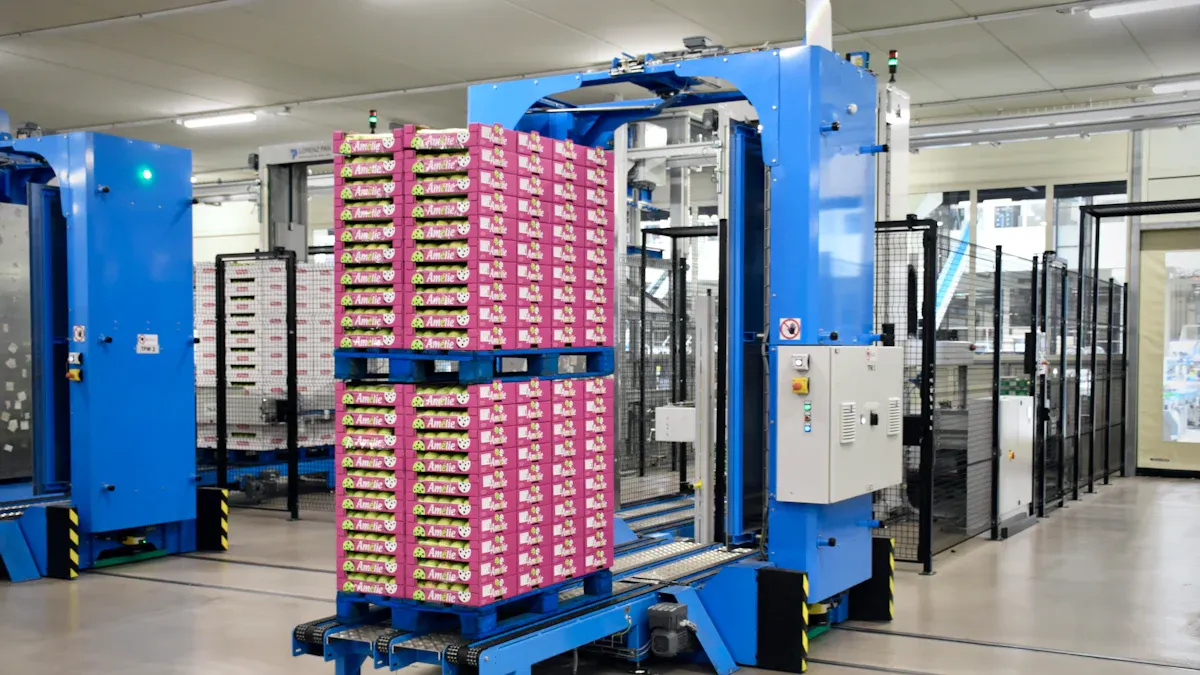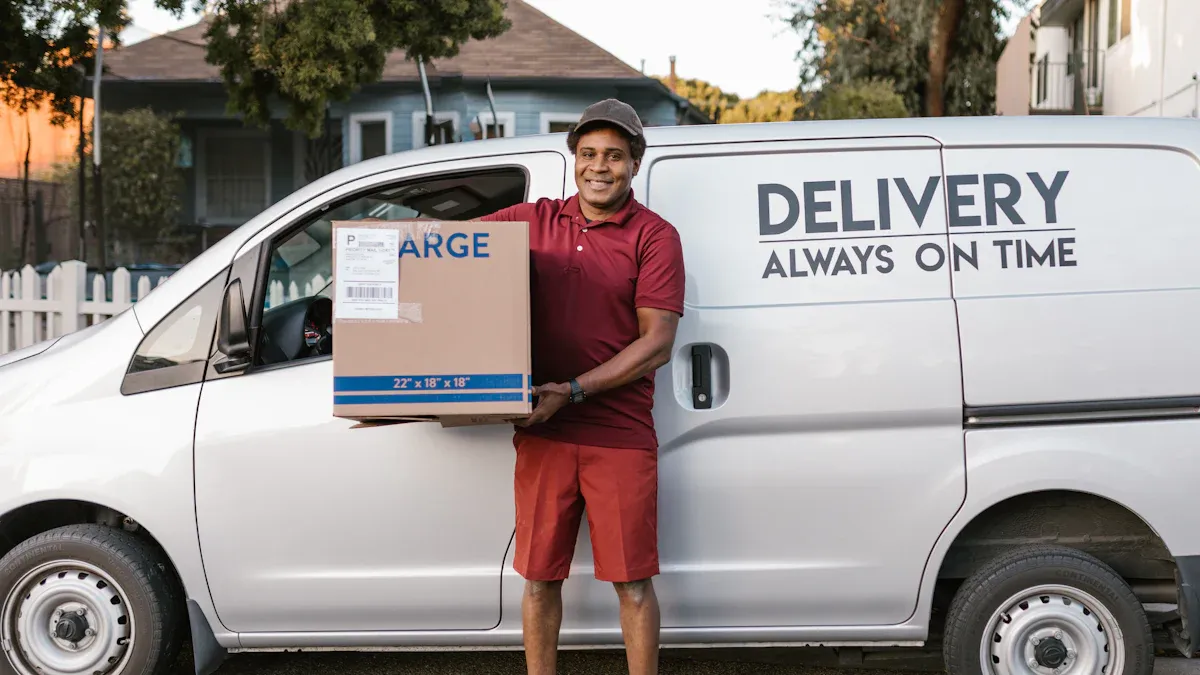How Micro Fulfillment Centers Drive E-Commerce Growth

Micro fulfillment centers now transform the e-commerce landscape by enabling rapid, efficient, and cost-effective shipping. Companies convert office spaces into micro-fulfillment hubs to meet growing customer demand for faster shipping. North America leads this trend, with the e-commerce boom pushing micro-fulfillment centers to dominate the market. Automation, robotics, and AI drive adoption in both urban and suburban areas, allowing retailers to address shipping demand while reimagining underutilized office spaces. With projected global market growth to over $53 billion by 2032, micro-fulfillment ensures businesses keep pace with evolving shipping expectations and sustainability goals.
Metric/Aspect Statistic/Projection E-commerce segment market share 41.4% in 2025 Store-integrated micro fulfillment 39.8% market share in 2025 North America market share 40.9% in 2025 Global market size USD 6.61B (2025); USD 53.25B (2032) Technology drivers Automation, robotics, AI
Micro Fulfillment Centers Explained

Core Features
Micro fulfillment centers and micro-fulfillment centers represent a new approach to e-commerce logistics. These compact fulfillment centers are small, highly automated warehouses located close to urban customers. Most micro-fulfillment centers range from 5,000 to 15,000 square feet, much smaller than traditional fulfillment centers. Their compact size allows them to fit into dense city environments and even within existing retail or office spaces.
Key features of micro fulfillment centers include:
- Advanced automation, such as robotic arms, automated guided vehicles, and conveyor systems, which speed up picking, packing, and shipping.
- Sophisticated inventory management software powered by artificial intelligence, providing real-time tracking and reducing errors.
- High-density order fulfillment, enabling hundreds or thousands of orders per hour with minimal human intervention.
- Scalability and flexibility, allowing rapid deployment and adaptation to changing demand.
- Limited inventory storage, usually enough for one to two days, which requires frequent restocking but keeps products fresh and close to consumers.
Compared to traditional fulfillment centers, micro-fulfillment centers focus on speed and proximity. They support omnichannel fulfillment, including curbside pickup, online orders, and in-store pickup. Store-integrated micro-fulfillment centers operate within existing retail locations, while standalone micro-fulfillment centers function as dedicated "dark stores" optimized for order processing.
Table: Micro Fulfillment Centers vs. Traditional Fulfillment Centers
| Aspect | Micro Fulfillment Centers | Traditional Fulfillment Centers |
|---|---|---|
| Size and Location | Small, urban/office spaces | Large, suburban/rural |
| Automation Level | High (robots, AI) | Lower, more manual |
| Delivery Speed | Fast (same-day/next-day) | Slower |
| Storage Capacity | Limited, frequent restocking | Large, long-term storage |
| Labor Costs | Lower (automation) | Higher (manual labor) |
Urban and Office Space Integration
Micro-fulfillment centers thrive in urban environments where fast delivery matters most. Businesses often repurpose office spaces or unused retail areas to create these compact fulfillment centers. This approach reduces delivery times and transportation costs by placing inventory closer to customers.
Urban integration involves several strategies:
- Utilizing existing office spaces and retail locations to minimize construction and maximize real estate value.
- Installing modular and scalable automation systems that fit within small footprints, sometimes as little as 500 to 1,500 square meters.
- Leveraging vertical storage and ergonomic designs to optimize space and improve worker productivity.
- Adapting to operational constraints, such as temperature zones for groceries or dynamic layouts for apparel.
Standalone micro-fulfillment centers and store-integrated micro-fulfillment centers both use high-density storage and automation to fit into limited urban spaces. These solutions support rapid order fulfillment, sometimes within an hour, and enable businesses to overcome challenges like expensive real estate and labor shortages. By transforming underused office spaces into micro-fulfillment hubs, companies gain agility and meet the growing demand for fast, local delivery.
E-Commerce Transformation

Faster Delivery
Micro fulfillment centers have changed the pace of e-commerce shipping. These facilities sit close to urban customers, which means packages travel shorter distances. Businesses can now offer same-day delivery and next-day delivery for many online orders. Micro-fulfillment centers store fast-moving products in small spaces, so workers and robots can pick and pack items quickly. Automation speeds up every step, from inventory checks to shipping labels.
- Micro-fulfillment centers use advanced robotics and software to process hundreds of online orders per hour.
- Companies can restock these centers often, keeping popular items available for immediate shipping.
- E-commerce retailers can adapt to spikes in demand, such as holidays or special sales, without delays.
This approach leads to faster delivery times and helps brands meet the expectations of direct-to-consumer shoppers. Many customers now expect their online orders to arrive within hours, not days. Micro fulfillment centers make this possible by reducing the gap between order and delivery.
🚚 Tip: Locating micro-fulfillment centers in city centers or near residential areas allows e-commerce companies to promise and deliver on rapid shipping, even during peak demand.
Last-Mile Efficiency
Last mile delivery remains the most expensive and complex part of e-commerce logistics and supply chains. Micro fulfillment centers address this challenge by placing inventory closer to customers. This strategy reduces last-mile delivery distances, lowers shipping costs, and improves supply chain efficiency.
| Evidence Aspect | Supporting Data / Explanation |
|---|---|
| Order Handling Capacity | Some micro-fulfillment centers process up to 15,000 orders per week. |
| Last-Mile Delivery Cost | Last-mile delivery accounts for 41% of total supply chain costs; MFCs reduce these costs. |
| Cost Reduction in Fulfillment | Automation and robotics in MFCs can cut order fulfillment costs by up to 75%. |
| Delivery Speed | MFCs enable faster delivery, meeting the demand of 88% of online customers for same-day service. |
| Technology Use | AI, IoT, and robotics improve order accuracy and operational efficiency. |
| Environmental Impact | Reduced long-haul transport lowers carbon footprint and improves reliability. |
| Space Efficiency | MFCs store more inventory per square foot, reducing space and operating costs. |
Micro-fulfillment centers also support batching, where several online orders are delivered in one trip. This method increases operational efficiency and further reduces last mile delivery costs. Integration with local couriers, bike fleets, and even drones adds flexibility and speed to the last-mile strategy. By decentralizing inventory, e-commerce brands can avoid bottlenecks and keep shipping times short, even when demand surges.
Customer Satisfaction
Customer satisfaction in e-commerce depends on fast, reliable shipping and product availability. Micro fulfillment centers help businesses achieve higher customer satisfaction by meeting these needs. They use automation and real-time inventory management to ensure that products are always in stock and ready for immediate shipping.
- A McKinsey & Company study found that 70% of customers will pay more for faster shipping.
- Micro-fulfillment centers enable accurate delivery windows, which builds trust and reduces frustration.
- Same-day and next-day delivery options increase customer loyalty and encourage repeat purchases.
- Smaller retailers can now compete with large e-commerce platforms by offering similar shipping speeds and service quality.
Micro-fulfillment centers also allow for curbside pickup and click-and-collect services, which many customers prefer for convenience and lower shipping costs. Real-time tracking and data analytics help businesses monitor delivery performance and quickly address any issues. By shortening delivery routes and improving order accuracy, micro-fulfillment centers create a seamless shopping experience that keeps customers coming back.
📈 Note: Quick and reliable shipping, powered by micro-fulfillment, leads to repeat business and stronger brand loyalty in the competitive e-commerce market.
Micro-Fulfillment Technology
Automation and Robotics
Automation and robotics now shape the core of micro-fulfillment operations. Companies use Automated Storage and Retrieval Systems (AS/RS) to store thousands of products in small spaces and retrieve them quickly. Autonomous Mobile Robots (AMRs) move goods inside the center, helping with picking and transporting items. Robotic arms and shuttle systems deliver products directly to workers, which increases speed and accuracy. These technologies allow micro-fulfillment centers to process hundreds of orders per hour, supporting same-day or even same-hour shipping.
- Robotics automate repetitive tasks like picking, packing, and sorting, which reduces errors and physical strain on workers.
- Automation shortens delivery times and improves order accuracy, leading to better customer experiences.
- Companies like Ariat and Decathlon have seen productivity double or triple after adding picking robots and AMRs.
Micro-fulfillment centers use these tools to maximize space in urban areas and keep shipping fast and cost-effective. This approach helps e-commerce businesses meet high demand and overcome labor shortages.
AI and Analytics
Artificial Intelligence (AI) and analytics drive better inventory management and order processing in micro-fulfillment centers. AI gives real-time visibility into inventory, reducing mistakes from manual counts. It predicts when to restock products and how much to order, which lowers costs and prevents stockouts. AI also analyzes sales trends and outside factors to forecast demand, helping e-commerce companies keep the right products available.
- AI optimizes warehouse layouts and picking routes, making order fulfillment faster.
- Integration with other systems, like ERP and CRM, creates smooth operations across the supply chain.
- AI detects unusual patterns in inventory data, which helps prevent loss and fraud.
These improvements make micro-fulfillment centers more efficient and scalable, allowing them to process orders quickly and keep up with changing e-commerce needs.
Platform Integration
Platform integration connects micro-fulfillment centers with e-commerce platforms and other business systems. Advanced Warehouse Management Systems (WMS) handle pick-and-pack, shipping, and returns. They provide real-time inventory updates, which helps avoid stockouts and overstocking. WMS integration with platforms like Shopify, Amazon, and WooCommerce allows automatic order transmission and shipment tracking.
| Integration Feature | Benefit for E-Commerce Fulfillment |
|---|---|
| Real-time inventory sync | Reduces errors and improves order accuracy |
| Automated order processing | Speeds up fulfillment and shipping |
| Shipment tracking | Keeps customers informed |
| Flexible APIs | Supports custom business needs |
This seamless data flow reduces manual work, speeds up shipping, and improves customer satisfaction. As e-commerce grows, platform integration ensures micro-fulfillment centers can scale and adapt to new challenges.
Transforming Office Space
Repurposing for Fulfillment
Companies now see underutilized office spaces as valuable assets for micro-fulfillment. Many micro-fulfillment centers emerge in empty office buildings, vacant retail locations, or even parking garages. Businesses often convert these spaces into logistics hubs by adapting the existing infrastructure. They install automation systems, reconfigure layouts, and add security features to support inventory management and order processing. Some centers operate as hybrids, combining in-person shopping with fulfillment, while others use a "ship from store" model to speed up delivery. Local governments sometimes require zoning changes before these conversions can happen. Public-private partnerships and financial incentives, such as climate-focused funding, help make these projects possible.
🏢 Adaptive reuse of office spaces supports mixed-use development and brings new life to commercial districts.
Operational Benefits
Transforming office space into micro-fulfillment centers delivers strong operational efficiency. Companies report much faster setup times, often completing conversions in four to six months instead of the 18 to 24 months needed for traditional warehouses. Proximity to customers allows delivery in as little as 30 minutes. Automation and technology integration boost inventory accuracy to over 99%. Labor efficiency improves, with up to 70% less labor required per order. Businesses also see higher sales per square foot and can offer services like curbside pickup and same-day delivery.
| Operational Benefit | Description / Metrics Reported |
|---|---|
| Setup Time | 4-6 months (vs. 18-24 for warehouses) |
| Delivery Speed | 30 minutes to 2 hours |
| Last-Mile Cost Savings | 30-50% reduction per order |
| Inventory Accuracy | 99.5% or higher |
| Labor Efficiency | 60-70% less labor per order |
| Sales per Square Foot | 15-25% higher |
| Omnichannel Capabilities | BOPIS, curbside, same-day delivery |
Specialty retailers benefit by managing their own fulfillment and maintaining brand identity. Small and medium e-commerce companies use these centers to reach customers quickly in key markets.
Sustainability Impact
Micro-fulfillment centers located in urban office spaces help reduce carbon emissions. Shorter delivery routes mean less fuel use and lower last-mile emissions. Research shows that curbside pickup from these centers produces fewer emissions than traditional in-store shopping. Compact layouts and energy-efficient operations further lower the carbon footprint. Accenture projects that local fulfillment centers could cut last-mile supply chain emissions by up to 26% by 2025. Accurate inventory management at these centers also helps decrease waste and emissions.
- Faster delivery with fewer miles traveled
- Lower emissions from last-mile logistics
- More energy-efficient than traditional retail stores
- Curbside pickup and grocery delivery reduce the need for individual car trips
🌱 Micro-fulfillment centers support sustainability goals by making e-commerce logistics cleaner and more efficient.
Challenges and Considerations
Implementation Barriers
Businesses face several hurdles when setting up micro-fulfillment centers. Limited storage space means frequent inventory replenishment. Companies often struggle to keep up with sudden changes in consumer demand, which can lead to stockouts for popular products. Space constraints force businesses to prioritize which products to store, making it difficult to handle larger items. Order consolidation becomes challenging when some items are out of stock, causing delivery delays or cancellations. These issues can lower customer satisfaction.
Other barriers include:
- Inefficiencies in combining manually picked items with automated systems, which slow down order processing.
- Manual in-store fulfillment software has improved, making automated solutions less attractive in some cases.
- Rising living costs push some consumers to prefer in-store shopping, reducing demand for micro-fulfillment.
- Hidden costs, such as construction delays and process changes, can hurt return on investment.
- Flexibility and scalability remain difficult, as automation providers must adapt solutions for different facility sizes.
⚠️ Businesses must weigh these challenges against the benefits to ensure successful implementation.
Space and Zoning
Local zoning laws and space constraints play a major role in the placement of micro-fulfillment centers. Cities often struggle to classify these centers, as they blend retail and warehouse functions. Some communities update ordinances to define and regulate micro-fulfillment centers, focusing on delivery traffic, building design, and operating hours. These rules help protect neighborhood character and manage environmental concerns.
In some places, like Morgan Hill, California, zoning changes have limited or even banned large fulfillment centers. The city set strict requirements for building size, height, and loading docks to address community concerns about traffic and neighborhood impact. Urban areas often allow micro-fulfillment centers in commercial districts but set size limits and design standards to encourage the reuse of existing buildings.
Workforce and Training
Operating highly automated micro-fulfillment centers brings workforce and training challenges. Many retailers still rely on manual picking, as automated solutions require significant investment and market conditions remain uncertain. Labor shortages and rising costs increase interest in automation, especially as the workforce ages and manual pickers become harder to find.
Employees often worry about job security and lack technical skills for new systems. Nearly 60% of warehouse workers express concern about automation's impact on their jobs. Training programs, such as hands-on workshops and e-learning, help upskill employees and ease the transition. Phased automation rollouts improve adoption rates, while clear communication about benefits and new career paths in robotics and data analysis fosters a positive workplace culture. Modern ergonomic systems also reduce physical strain, making these jobs more attractive and improving retention.
💡 Upskilling and open communication help teams adapt to automation and create new opportunities in the evolving logistics landscape.
Micro-fulfillment centers now play a pivotal role in e-commerce growth and urban logistics. Recent case studies show that these centers, located near city populations, reduce delivery times and costs while supporting sustainable logistics with electric vehicles. Advanced automation and real-time tracking improve delivery reliability and customer satisfaction. By repurposing office and retail spaces, micro-fulfillment centers help cities adapt to changing demands, manage peak periods, and lower emissions. As technology evolves, these centers will continue to shape efficient, adaptable, and sustainable urban environments.
FAQ
What is a micro-fulfillment center?
A micro-fulfillment center is a small, automated warehouse located near customers. It stores popular products and uses robotics to pick and pack orders quickly. Retailers use these centers to speed up delivery and reduce shipping costs.
How do micro-fulfillment centers improve delivery speed?
Micro-fulfillment centers sit close to urban shoppers. They use automation to process orders fast. This setup allows companies to offer same-day or next-day delivery, meeting customer expectations for quick shipping.
Can small businesses use micro-fulfillment centers?
Yes, small businesses can benefit from micro-fulfillment centers. These centers help them compete with larger retailers by offering fast delivery and efficient order processing. Many providers offer flexible solutions for different business sizes.
What technology powers micro-fulfillment centers?
Micro-fulfillment centers rely on robotics, artificial intelligence, and advanced software. These tools automate picking, packing, and inventory management. Real-time data helps companies track orders and restock products efficiently.
Are micro-fulfillment centers environmentally friendly?
🌱 Micro-fulfillment centers reduce delivery distances and use energy-efficient systems. This approach lowers carbon emissions and supports sustainability goals for e-commerce businesses.
See Also
Driving Business Expansion Through Outsourced Supply Chain Solutions
The Importance Of SaaS WMS For Modern Warehouse Efficiency
Top Brands Accelerate Growth Using WarpDriven Distribution Technology
New EDI Tracking Advances Enhancing Future Shipment Transparency
Three Methods Lean Logistics Improves Sustainable Supply Chains